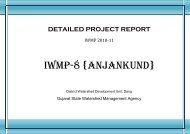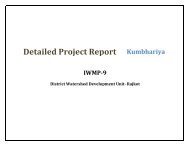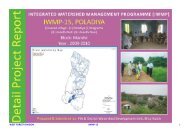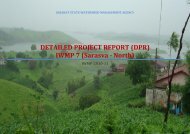IWMP-2 - Commissionerate of Rural Development Gujarat State ...
IWMP-2 - Commissionerate of Rural Development Gujarat State ...
IWMP-2 - Commissionerate of Rural Development Gujarat State ...
You also want an ePaper? Increase the reach of your titles
YUMPU automatically turns print PDFs into web optimized ePapers that Google loves.
Detailed Project Report <strong>IWMP</strong>-2<br />
Production system: Soya bean Cultivation<br />
Introduction<br />
Agriculture improvement is a personal agenda for the farmers; unlike watershed projects. Encouraging small and marginal farmers for adopting new crop verities<br />
will be benefited to small and marginal framers for better return from agriculture. Entrepreneur farmers are producing agricultural commodities (both food and<br />
non-food crops) for commercial purposes. Their agricultural production is either sold in local markets or exported abroad, mainly through an export agent or<br />
wholesaler. In last decade, Soybean production has increased tremendously. Farmers are more likely to start growing soya if they know more about its advantages.<br />
We have already mentioned that it is a good source <strong>of</strong> nutrition and provides a welcome addition to diets that are not well balanced. Market <strong>of</strong> soya bean cultivation<br />
is increasing with good number as giving good return on investment through local market as well as foreign market.<br />
General background on the plant<br />
Family: Leguminosae (sub family: Papilionoideae)<br />
Genus: Glycine<br />
Species: max<br />
Soybeans A legume, the botanical name <strong>of</strong> which is Glycine max (L) Merrill. Often referred to as the miracle crop, the soybean is the world’s leading provider <strong>of</strong><br />
protein and oil. Beans are classed as pulses whereas soybeans are classed as oilseeds. The word soy is derived from the Japanese word-shoyu-<br />
(soysauce/soyasauce). Soybean is the single largest oilseed produced in the World. Soybeans grow on a variety <strong>of</strong> soils and a wide range <strong>of</strong> climates. Soya bean can<br />
be grown under a wide range <strong>of</strong> agro climatic conditions. It is suitable for warm, humid climates. As soybeans mature in the pod, they ripen into hard, dry beans.<br />
Although most soybeans are yellow, there are also rare varieties which are black, brown or green coloured. Soya beans mature in the pod; they ripen into a hard,<br />
dry bean then. A given area <strong>of</strong> land planted with soybeans can produce much more protein than land planted with other crops, or if the land were used to raise<br />
cattle.<br />
The stems are up to 1.8 m tall and it is sometimes vine-like. The axillaries irregular racemes are <strong>of</strong>ten leafy and short (10 - 35) with 5 - 8 flowers. The corollas are<br />
white, pink, greenish blue, violet or purple and 4.5 - 7 mm long., the pods are oblong, 25 - 75 mm long, 8-15 mm broad, yellowish brown, with bristly hairs. There<br />
are 2-3 seeds per pod which are ovoid to sub-spherical, 6 - 11 x 5 - 8mm in size and greenish cream or greyish-olive to reddish black, and smooth.<br />
<strong>Gujarat</strong> <strong>State</strong> Watershed Management Agency<br />
125 | P a g e
















